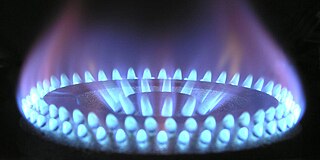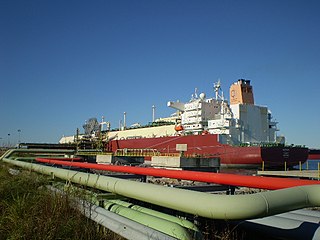
Natural gas is a naturally occurring mixture of gaseous hydrocarbons consisting primarily of methane in addition to various smaller amounts of other higher alkanes. Low levels of trace gases like carbon dioxide, nitrogen, hydrogen sulfide, and helium are also usually present. Methane is colorless and odorless, and the second largest greenhouse gas contributor to global climate change after carbon dioxide. Because natural gas is odorless, odorizers such as mercaptan are commonly added to it for safety so that leaks can be readily detected.

Alternative fuels, also known as non-conventional and advanced fuels, are fuels derived from sources other than petroleum. Alternative fuels include gaseous fossil fuels like propane, natural gas, methane, and ammonia; biofuels like biodiesel, bioalcohol, and refuse-derived fuel; and other renewable fuels like hydrogen and electricity.
Cryogenic fuels are fuels that require storage at extremely low temperatures in order to maintain them in a liquid state. These fuels are used in machinery that operates in space where ordinary fuel cannot be used, due to the very low temperatures often encountered in space, and the absence of an environment that supports combustion. Cryogenic fuels most often constitute liquefied gases such as liquid hydrogen.

Liquefied natural gas (LNG) is natural gas (predominantly methane, CH4, with some mixture of ethane, C2H6) that has been cooled down to liquid form for ease and safety of non-pressurized storage or transport. It takes up about 1/600th the volume of natural gas in the gaseous state (at standard conditions for temperature and pressure).

A Natural Gas Vehicle (NGV) is an alternative fuel vehicle that uses compressed natural gas (CNG) or liquefied natural gas (LNG). Natural gas vehicles should not be confused with autogas vehicles powered by liquefied petroleum gas (LPG), mainly propane, a fuel with a fundamentally different composition.
Hydrogen fuel refers to hydrogen which is burned as fuel with pure oxygen. It can be a zero-carbon fuel, provided that it is created in a process that does not involve carbon. However, most hydrogen comes from fossil fuels, resulting in carbon dioxide emissions. Depending on the source and the resulting environmental impact, hydrogen that is sourced from various methods can be referred to by a variety of terms using metaphorical names of colors: white, green, blue, grey, black, or brown hydrogen. It can be used in fuel cells or internal combustion engines. Regarding hydrogen vehicles, hydrogen has begun to be used in commercial fuel cell vehicles such as passenger cars, and has been used in fuel cell buses for many years. It is also used as a fuel for spacecraft propulsion and is being proposed for hydrogen-powered aircraft. The fuel technology has seen awakened interest from automakers who claim it is comparatively cheap and safer to incorporate into the modern vehicle architecture over recent challenges faced by electric vehicle makers.

S-class ferries are roll-on/roll-off (RORO) ferries operated by BC Ferries in British Columbia, Canada. They are the largest ferries in the BC Ferries fleet. The class comprises two ships, Spirit of British Columbia and Spirit of Vancouver Island, which were completed in 1993 and 1994 respectively. They serve the ferry route between Tsawwassen and Swartz Bay. In 2017, the class underwent conversion to a dual-fuel propulsion system that would allow them to use either marine diesel fuel or liquefied natural gas.

Methane Princess and Methane Progress were the first purpose-built LNG carriers, entering service in 1964 and used to transport natural gas from Algeria to the UK. Methane Princess was built at the Vickers shipyard at Barrow-in-Furness and her sister by Harland and Wolff in Belfast.
LNG El Paso Sonatrach was a liquefied natural gas carrier (LNG) of the El Paso Marine Corporation which was active in the late 1970s. Although she was US owned, the ship was registered in Liberia because of tax and economical reasons.

Marine propulsion is the mechanism or system used to generate thrust to move a watercraft through water. While paddles and sails are still used on some smaller boats, most modern ships are propelled by mechanical systems consisting of an electric motor or internal combustion engine driving a propeller, or less frequently, in pump-jets, an impeller. Marine engineering is the discipline concerned with the engineering design process of marine propulsion systems.

An LNG carrier is a tank ship designed for transporting liquefied natural gas (LNG).
Q-Flex is a type of ship, specifically a membrane type liquefied natural gas carrier.

Q-Max is a type of ship, specifically a membrane type LNG carrier. In the name Q-Max, "Q" stands for Qatar and "Max" for the maximum size of ship able to dock at the Liquefied natural gas (LNG) terminals in Qatar. Ships of this type are the largest LNG carriers in the world.

A hydrogen tanker is a tank ship designed for transporting liquefied hydrogen.
A liquid nitrogen vehicle is powered by liquid nitrogen, which is stored in a tank. Traditional nitrogen engine designs work by heating the liquid nitrogen in a heat exchanger, extracting heat from the ambient air and using the resulting pressurized gas to operate a piston or rotary motor. Vehicles propelled by liquid nitrogen have been demonstrated, but are not used commercially. One such vehicle, Liquid Air, was demonstrated in 1902.

A gas carrier, gas tanker, LPG carrier, or LPG tanker is a ship designed to transport LPG, LNG, CNG, or liquefied chemical gases in bulk.

A liquefied natural gas terminal is a facility for managing the import and/or export of liquefied natural gas (LNG). It comprises equipment for loading and unloading of LNG cargo to/from ocean-going tankers, for transfer across the site, liquefaction, re-gasification, processing, storage, pumping, compression, and metering of LNG. LNG as a liquid is the most efficient way to transport natural gas over long distances, usually by sea.

MS Megastar is a fast ro-ro/passenger (ro-pax) ferry built by the Meyer Turku shipyard in Turku, Finland, for the Estonian shipping company Tallink. The 230 million euro vessel is the first ship in Tallink's fleet to use liquefied natural gas (LNG) as fuel.
Gaztransport & Technigaz SA is a French multinational naval engineering company with headquarters in Saint-Rémy-lès-Chevreuse, France.
The Höegh Esperanza is a Floating Storage and Regasification Unit (FSRU) ship owned by Höegh LNG Holdings. From the end of 2022 the FSRU will be used in the Wilhelmshaven LNG terminal.













